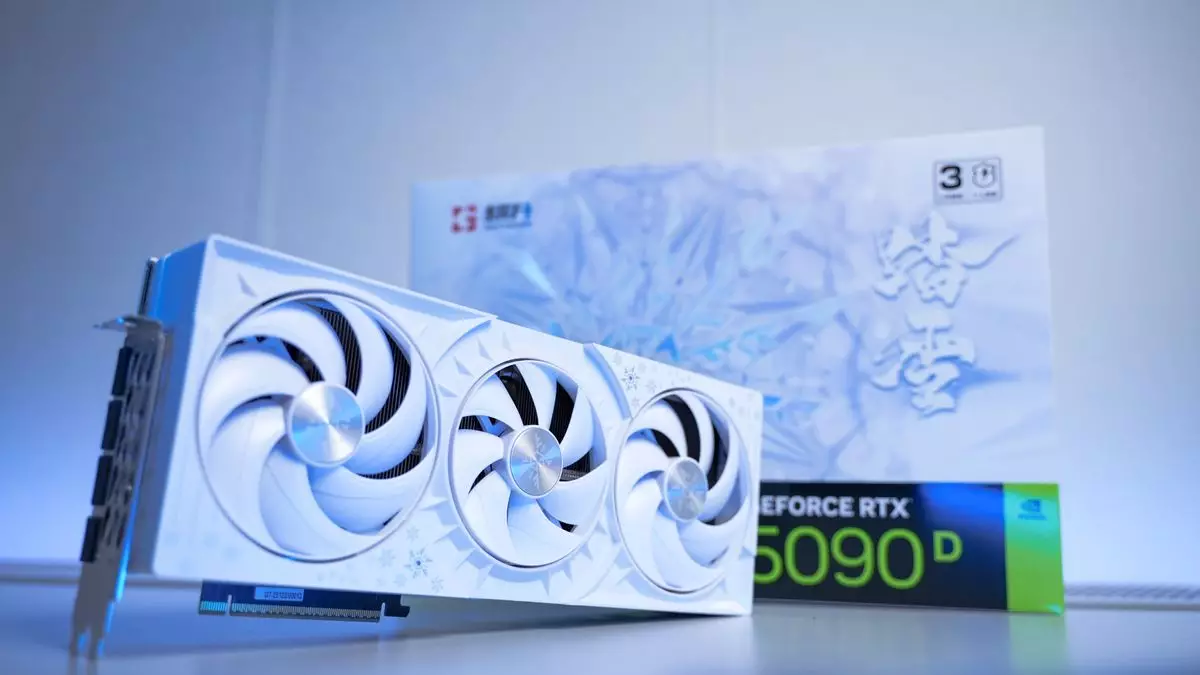The fast-approaching release of Nvidia’s RTX 50 series heralds a new era in the world of graphics processing units (GPUs). Among the anticipated models, the Gainward RTX 5090 D has garnered attention—not only for its performance capabilities but also for its visually stunning design. The unique aesthetic, coupled with the complexities surrounding its launch, begs the question: what does the RTX 5090 D signify for consumers and the market at large?
At a first glance, the Gainward RTX 5090 D is hard to resist. Its frosty white exterior, adorned with the motif of delicate snowflakes and sharp thorns encircling its central fan, exudes an air of elegance. Gainward’s branding, displayed prominently on the back and side, may typically seem excessive, yet in this instance, it feels justified. The GPU’s beauty transcends typical design standards, transforming it into a piece of art that could easily be the centerpiece of any gaming setup.
While I ordinarily advocate for minimalistic branding in tech products, the design of the RTX 5090 D makes an exception. Its ethereal aesthetic resonates with players seeking not just functionality but also a visually striking addition to their rigs. This GPU is not just created for playing games but also for elevating the overall visual appeal of a gaming environment.
However, one must address the elephant in the room: performance limitations. The RTX 5090 D, while visually captivating, is positioned as a lesser alternative to its regular RTX 5090 counterpart. Due to U.S. sanctions tied to technology exports, particularly those involving AI and cryptocurrency functions, this version features restricted performance metrics. Specifically, the Total Processing Performance (TPP) and Performance Density (TD) are tamed, making the RTX 5090 D a less powerful option.
This hybrid compromise raises concerns for enthusiasts who prioritize peak performance. The RTX 5090 D boasts the same 32 GB of GDDR7 RAM and an identical count of 21,760 CUDA cores as the standard model, yet it may not deliver on the expected computing power. As consumers, we are often torn between the desire for aesthetic allure and the fundamental need for high performance, making the choice a significant dilemma in the gaming community.
Amid the controversies surrounding Nvidia’s business practices, the market landscape has been scrutinized. As China launched an antitrust investigation into Nvidia’s acquisition of Mellanox Technologies, it became imperative for companies to adapt to a complicated web of international regulations. This has ultimately led to innovations like the RTX 5090 D, which represents an attempt to navigate these constraints—albeit with compromises on performance.
In light of these geopolitical tensions, the existence of the RTX 5090 D underscores a more significant issue: how corporations must maneuver through regulations while still providing products that appeal to consumers.
As potential buyers, we find ourselves at a crossroads: should we embrace a product that, while artistically pleasing, has potential limitations in capabilities? This is an essential conversation worth having in the current climate.
Despite the uncertainties of availability and pricing, the beauty of the Gainward RTX 5090 D has rekindled hope in me. The allure of exclusive gaming technology often has that effect. Products like the Pokemon-themed Razer gear or the Evangelion-themed OneXPlayer show that there is a market for exclusive aesthetics, especially in China. Yet, these appealing products often remain out of reach for many consumers globally.
The demand for exceptional design coupled with competent performance is resilient. In past instances, products that initially appeared as China exclusives, like the Sapphire Nitro+ RX 7900 GRE and Razer’s Kuromi collection, eventually made their way to wider markets. As gaming cultures clash and evolve, one can only hope to see similar outcomes for the RTX 5090 D.
Ultimately, the Gainward RTX 5090 D embodies a complex narrative. As much as it is a triumph of design, it is also a reminder of the underlying issues in tech markets today. We are at a junction where beauty doesn’t always equate to functionality. It’s grueling to consider investing in a product that may offer less power, even if it’s stunning to behold. Nonetheless, for aesthetics aficionados and dedicated fans, the RTX 5090 D stands as a hopeful testament to what beautiful gaming technology can look like, even amidst challenges.

